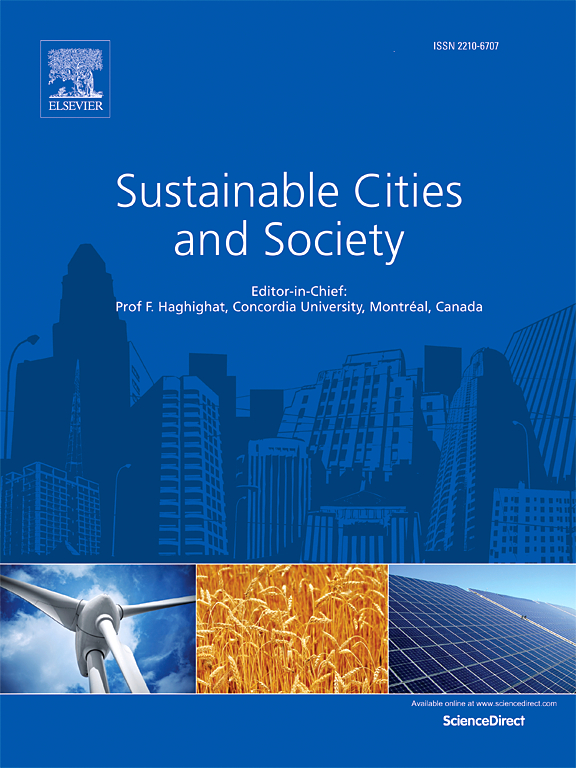Spatial-temporal variation of surface temperature and cold island network construction in the Yangtze River delta urban agglomeration: Perspectives from current and future scenarios
IF 10.5
1区 工程技术
Q1 CONSTRUCTION & BUILDING TECHNOLOGY
引用次数: 0
Abstract
In the context of global climate change and rapid urbanization, the Urban Cold Island (UCI) effect plays a crucial role in improving urban thermal environments and enhancing residents’ quality of life. Existing research primarily addresses urban heat issues from isolated blue-green space perspectives, with limited focus on the connectivity and spatiotemporal dynamics of cooling island networks. This study identified Cooling Island Core Sources (CICS), corridors, and cool nodes, and constructs cooling island networks from 2000 to 2020 using land surface temperature (LST) data. The study also predicted future cooling island networks by projecting LST for 2030 and 2060 under natural and dual-carbon scenarios. Results indicated the LST in the high-temperature areas generally exceeds 35 ℃, while the LST in the low-temperature areas is mostly below 28 ℃. Future scenario simulations indicate that the LST in high-temperature areas may increase by 2-4 ℃.In 2010 and 2020, the CICS expanded significantly in the southern and western regions, particularly around the Hefei and Hangzhou metropolitan areas, where connectivity-rich corridors had gradually increased. Under the carbon peaking and carbon neutrality goals in 2030 and 2060, cooling island network connectivity was notably higher than in natural development scenario, with the number and distribution of high-connectivity corridors expanding in the Suzhou-Hangzhou area. The cold island network system has transitioned from “centralized network” to “zonal network”, with its spatial layout shifting from large-scale dispersed pattern to small-scale clustered pattern, which is conducive to enhancing its effectiveness in mitigating the urban heat island effect.This study provides a scientific basis for urban blue-green space planning, offering new perspectives for constructing future cooling island networks.
长江三角洲城市群地表温度时空变化与冷岛网络建设——基于当前与未来情景的视角
在全球气候变化和快速城市化背景下,城市冷岛效应在改善城市热环境、提高居民生活质量方面发挥着至关重要的作用。现有研究主要从孤立的蓝绿空间角度解决城市热问题,对冷却岛网络的连通性和时空动态的关注有限。本文利用2000 - 2020年的地表温度数据,确定了冷却岛核心源(CICS)、走廊和冷节点,并构建了冷却岛网络。该研究还通过预测2030年和2060年自然和双碳情景下的地表温度来预测未来的冷却岛网络。结果表明,高温区地表温度普遍超过35℃,低温区大部分低于28℃。未来情景模拟表明,高温地区的地表温度可能升高2 ~ 4℃。2010年和2020年,CICS在南部和西部地区显著扩张,特别是在合肥和杭州大都市圈周围,那里的连通性丰富的走廊逐渐增加。在2030年和2060年碳调峰和碳中和目标下,冷却岛网络连通性显著高于自然发展情景,高连通性廊道数量和分布在苏杭地区不断扩大。冷岛网络系统由“集中式网络”向“地带性网络”转变,空间布局由大尺度的分散格局向小尺度的集聚格局转变,有利于增强其缓解城市热岛效应的有效性。该研究为城市蓝绿空间规划提供了科学依据,为未来冷岛网络的构建提供了新的视角。
本文章由计算机程序翻译,如有差异,请以英文原文为准。
求助全文
约1分钟内获得全文
求助全文
来源期刊

Sustainable Cities and Society
Social Sciences-Geography, Planning and Development
CiteScore
22.00
自引率
13.70%
发文量
810
审稿时长
27 days
期刊介绍:
Sustainable Cities and Society (SCS) is an international journal that focuses on fundamental and applied research to promote environmentally sustainable and socially resilient cities. The journal welcomes cross-cutting, multi-disciplinary research in various areas, including:
1. Smart cities and resilient environments;
2. Alternative/clean energy sources, energy distribution, distributed energy generation, and energy demand reduction/management;
3. Monitoring and improving air quality in built environment and cities (e.g., healthy built environment and air quality management);
4. Energy efficient, low/zero carbon, and green buildings/communities;
5. Climate change mitigation and adaptation in urban environments;
6. Green infrastructure and BMPs;
7. Environmental Footprint accounting and management;
8. Urban agriculture and forestry;
9. ICT, smart grid and intelligent infrastructure;
10. Urban design/planning, regulations, legislation, certification, economics, and policy;
11. Social aspects, impacts and resiliency of cities;
12. Behavior monitoring, analysis and change within urban communities;
13. Health monitoring and improvement;
14. Nexus issues related to sustainable cities and societies;
15. Smart city governance;
16. Decision Support Systems for trade-off and uncertainty analysis for improved management of cities and society;
17. Big data, machine learning, and artificial intelligence applications and case studies;
18. Critical infrastructure protection, including security, privacy, forensics, and reliability issues of cyber-physical systems.
19. Water footprint reduction and urban water distribution, harvesting, treatment, reuse and management;
20. Waste reduction and recycling;
21. Wastewater collection, treatment and recycling;
22. Smart, clean and healthy transportation systems and infrastructure;
 求助内容:
求助内容: 应助结果提醒方式:
应助结果提醒方式:


